air conditioning TOYOTA RAV4 PLUG-IN HYBRID 2023 Owners Manual
[x] Cancel search | Manufacturer: TOYOTA, Model Year: 2023, Model line: RAV4 PLUG-IN HYBRID, Model: TOYOTA RAV4 PLUG-IN HYBRID 2023Pages: 718, PDF Size: 167.55 MB
Page 6 of 718
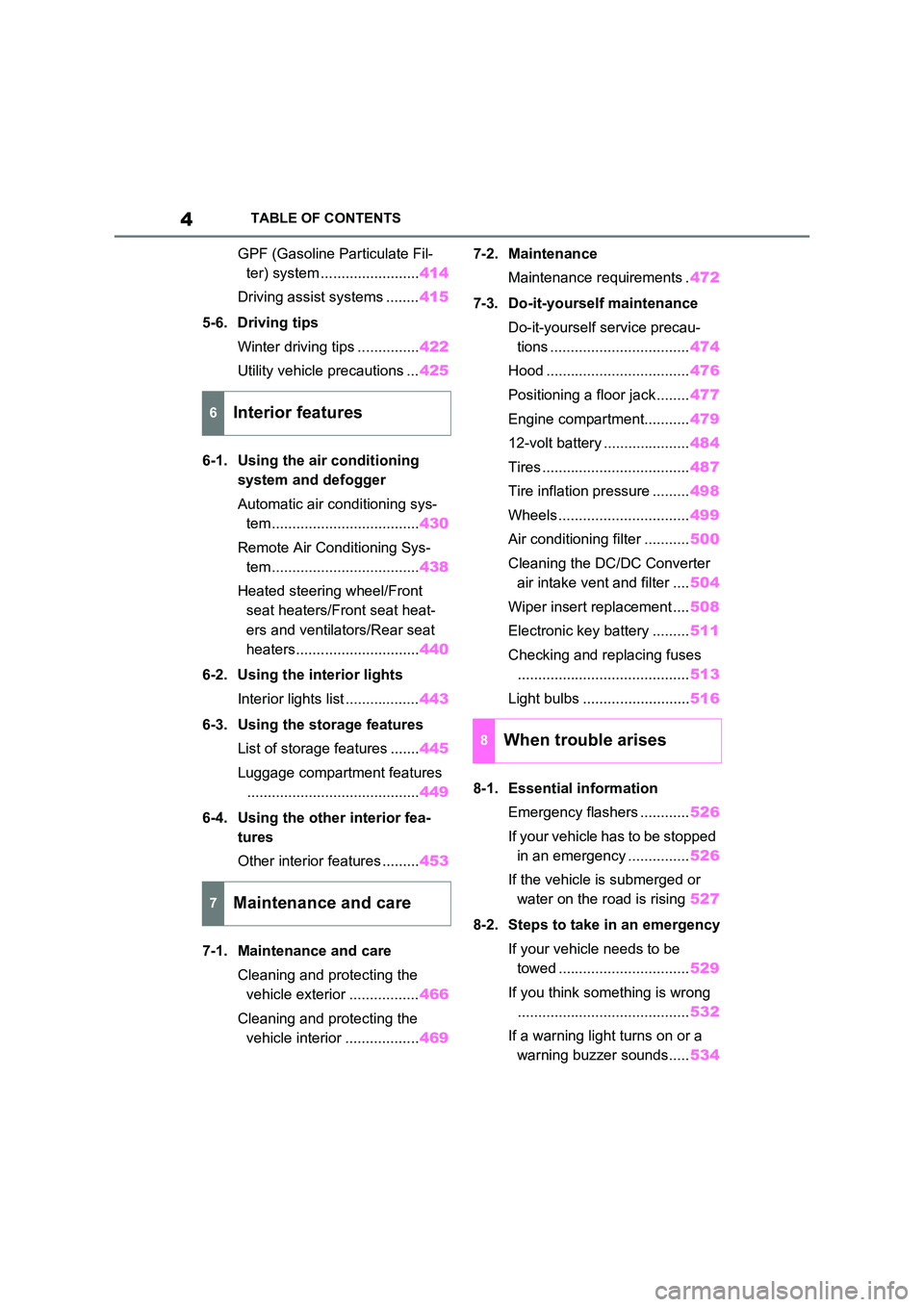
4TABLE OF CONTENTS
GPF (Gasoline Particulate Fil-
ter) system ........................ 414
Driving assist systems ........ 415
5-6. Driving tips
Winter driving tips ............... 422
Utility vehicle precautions ... 425
6-1. Using the air conditioning
system and defogger
Automatic air conditioning sys-
tem .................................... 430
Remote Air Conditioning Sys-
tem .................................... 438
Heated steering wheel/Front
seat heaters/Front seat heat-
ers and ventilators/Rear seat
heaters.............................. 440
6-2. Using the interior lights
Interior lights list .................. 443
6-3. Using the storage features
List of storage features ....... 445
Luggage compartment features
.......................................... 449
6-4. Using the other interior fea-
tures
Other interior features ......... 453
7-1. Maintenance and care
Cleaning and protecting the
vehicle exterior ................. 466
Cleaning and protecting the
vehicle interior .................. 469
7-2. Maintenance
Maintenance requirements . 472
7-3. Do-it-yourself maintenance
Do-it-yourself service precau-
tions .................................. 474
Hood ................................... 476
Positioning a floor jack ........ 477
Engine compartment........... 479
12-volt battery ..................... 484
Tires .................................... 487
Tire inflation pressure ......... 498
Wheels ................................ 499
Air conditioning filter ........... 500
Cleaning the DC/DC Converter
air intake vent and filter .... 504
Wiper insert replacement .... 508
Electronic key battery ......... 511
Checking and replacing fuses
.......................................... 513
Light bulbs .......................... 516
8-1. Essential information
Emergency flashers ............ 526
If your vehicle has to be stopped
in an emergency ............... 526
If the vehicle is submerged or
water on the road is rising 527
8-2. Steps to take in an emergency
If your vehicle needs to be
towed ................................ 529
If you think something is wrong
.......................................... 532
If a warning light turns on or a
warning buzzer sounds..... 534
6Interior features
7Maintenance and care
8When trouble arises
Page 18 of 718
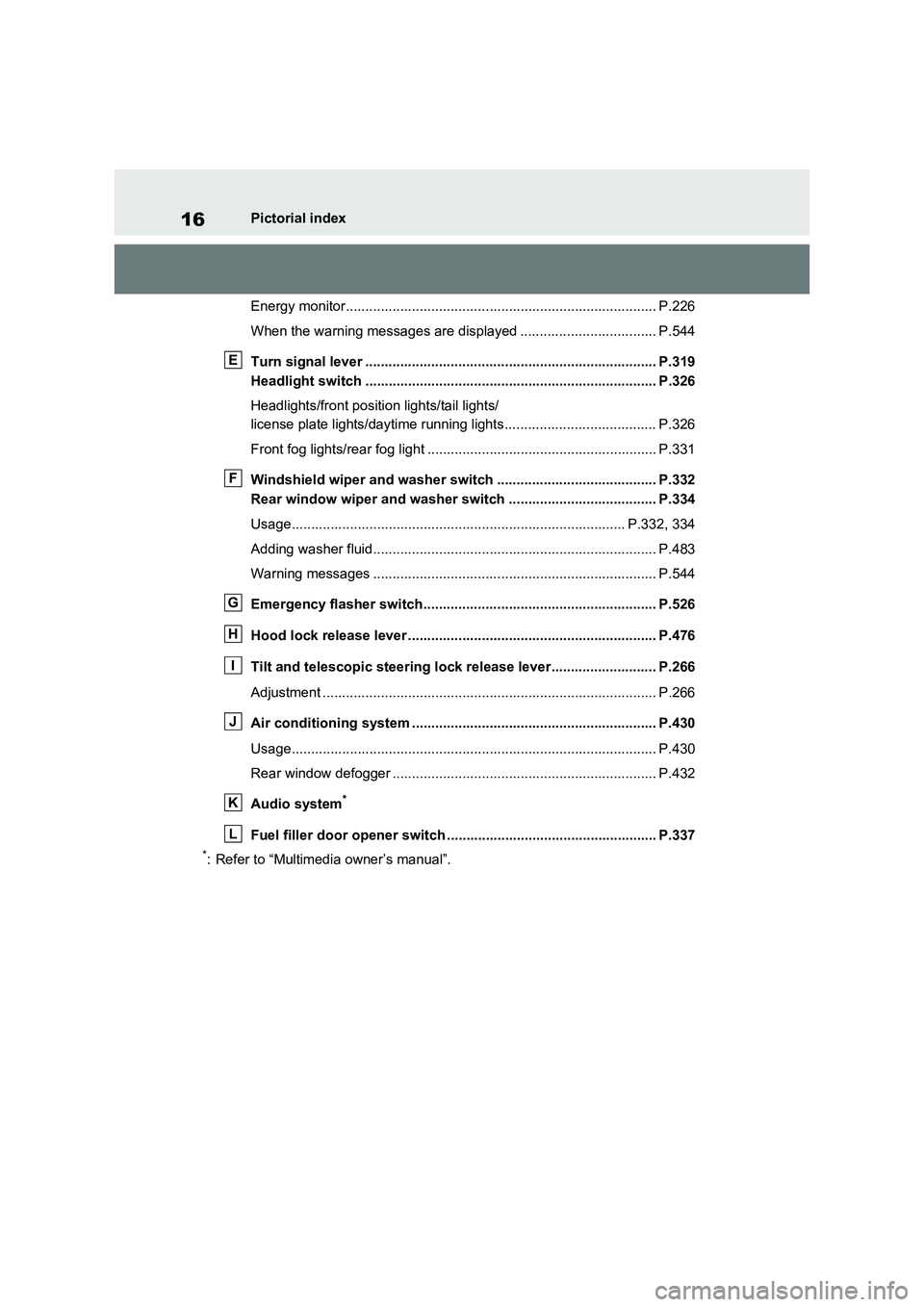
16Pictorial index
Energy monitor................................................................................ P.226
When the warning messages are displayed ................................... P.544
Turn signal lever ........................................................................... P.319
Headlight switch ........................................................................... P.326
Headlights/front position lights/tail lights/
license plate lights/daytime running lights....................................... P.326
Front fog lights/rear fog light ........................................................... P.331
Windshield wiper and washer switch ......................................... P.332
Rear window wiper and washer switch ...................................... P.334
Usage...................................................................................... P.332, 334
Adding washer fluid......................................................................... P.483
Warning messages ......................................................................... P.544
Emergency flasher switch............................................................ P.526
Hood lock release lever ................................................................ P.476
Tilt and telescopic steering lock release lever........................... P.266
Adjustment ...................................................................................... P.266
Air conditioning system ............................................................... P.430
Usage.............................................................................................. P.430
Rear window defogger .................................................................... P.432
Audio system
*
Fuel filler door opener switch ...................................................... P.337
*: Refer to “Multimedia owner’s manual”.
E
F
G
H
I
J
K
L
Page 26 of 718
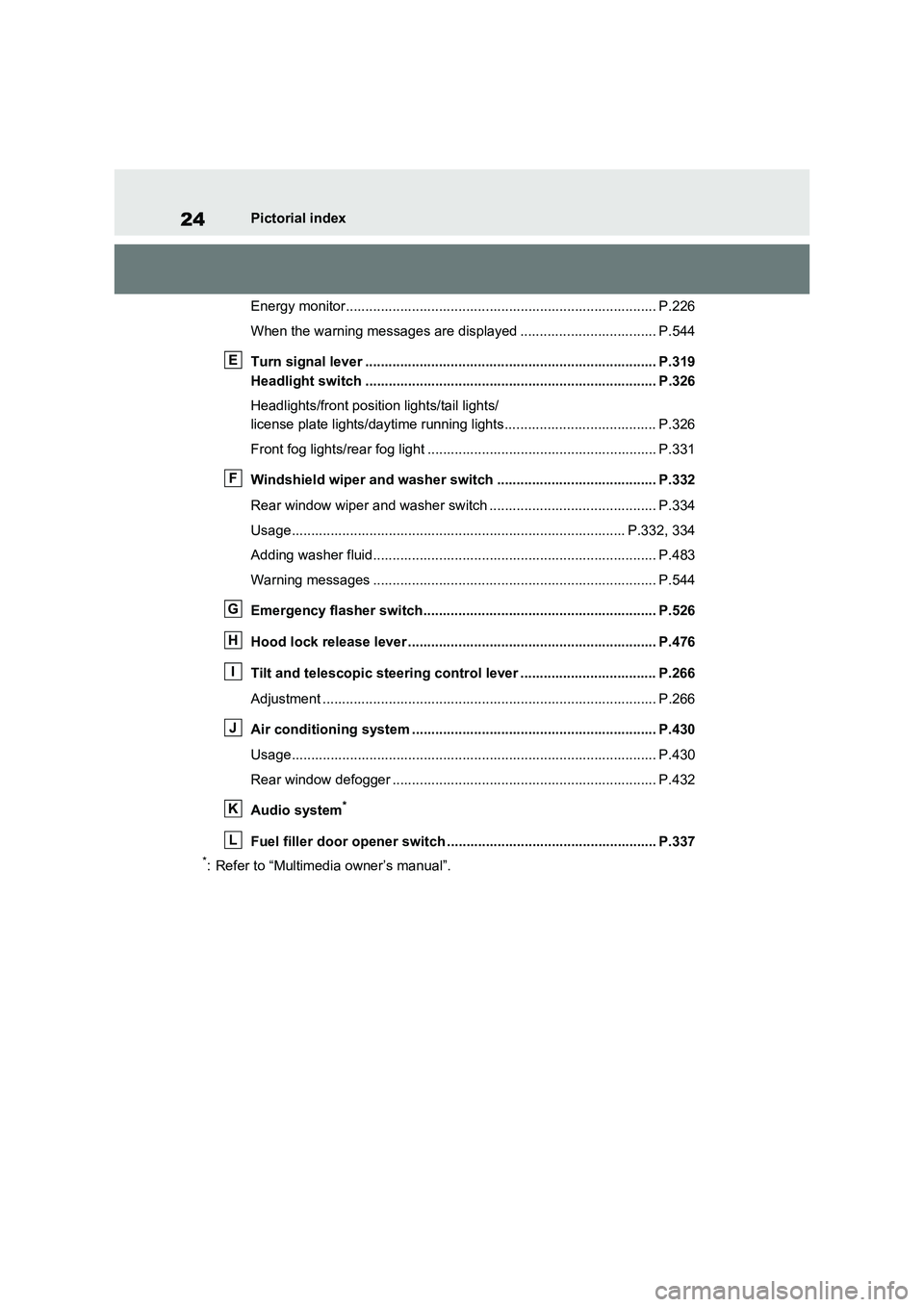
24Pictorial index
Energy monitor................................................................................ P.226
When the warning messages are displayed ................................... P.544
Turn signal lever ........................................................................... P.319
Headlight switch ........................................................................... P.326
Headlights/front position lights/tail lights/
license plate lights/daytime running lights....................................... P.326
Front fog lights/rear fog light ........................................................... P.331
Windshield wiper and washer switch ......................................... P.332
Rear window wiper and washer switch ........................................... P.334
Usage...................................................................................... P.332, 334
Adding washer fluid......................................................................... P.483
Warning messages ......................................................................... P.544
Emergency flasher switch............................................................ P.526
Hood lock release lever ................................................................ P.476
Tilt and telescopic steering control lever ................................... P.266
Adjustment ...................................................................................... P.266
Air conditioning system ............................................................... P.430
Usage.............................................................................................. P.430
Rear window defogger .................................................................... P.432
Audio system
*
Fuel filler door opener switch ...................................................... P.337
*: Refer to “Multimedia owner’s manual”.
E
F
G
H
I
J
K
L
Page 86 of 718
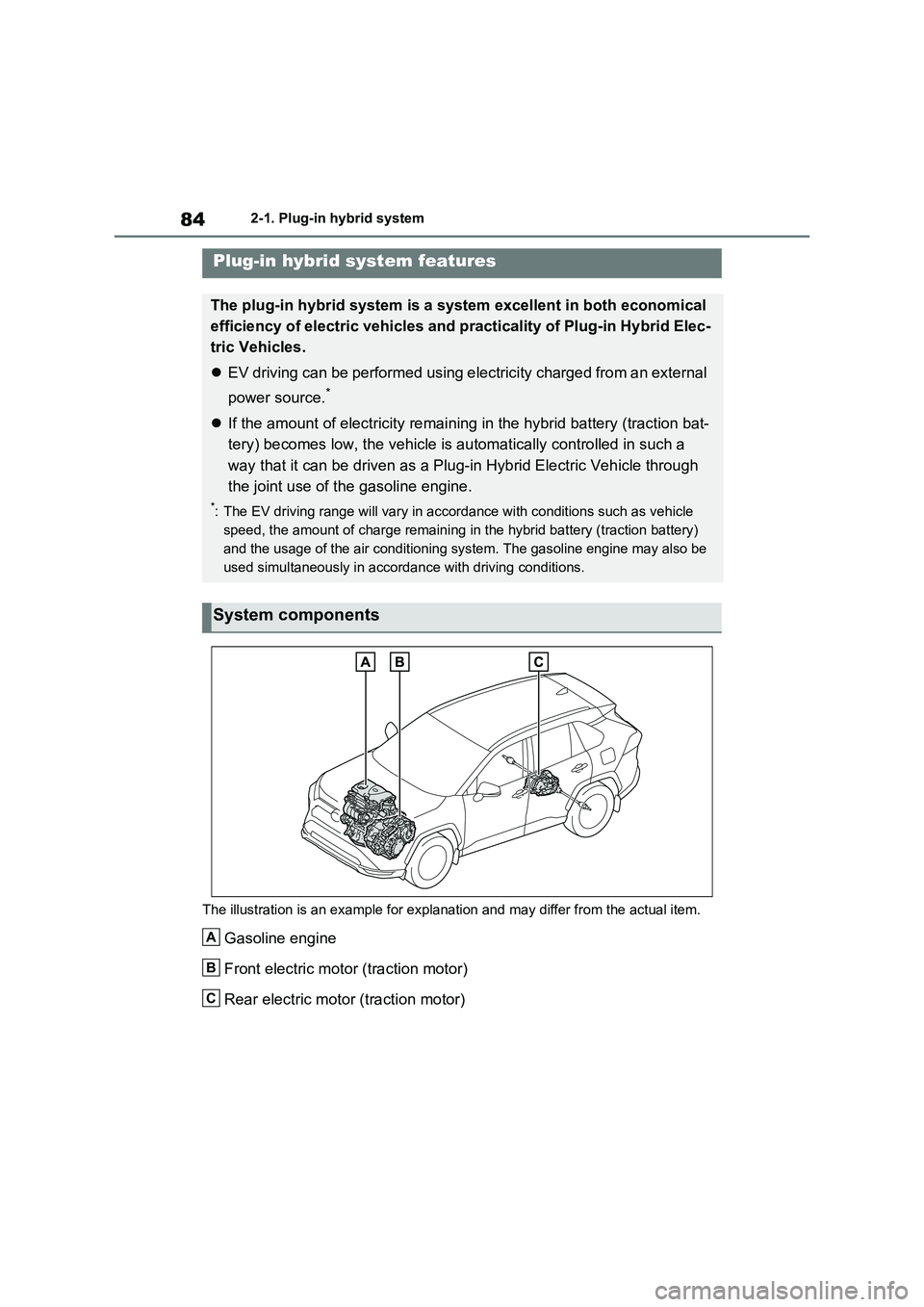
842-1. Plug-in hybrid system
2-1.Plug-in hyb rid s ystem
The illustration is an example for explanation and may differ from the actual item.
Gasoline engine
Front electric motor (traction motor)
Rear electric motor (traction motor)
Plug-in hybrid system features
The plug-in hybrid system is a system excellent in both economical
efficiency of electric vehicles and practicality of Plug-in Hybrid Elec-
tric Vehicles.
EV driving can be performed using electricity charged from an external
power source.
*
If the amount of electricity remaining in the hybrid battery (traction bat-
tery) becomes low, the vehicle is automatically controlled in such a
way that it can be driven as a Plug-in Hybrid Electric Vehicle through
the joint use of the gasoline engine.
*: The EV driving range will vary in accordance with conditions such as vehicle
speed, the amount of charge remaining in the hybrid battery (traction battery)
and the usage of the air conditioning system. The gasoline engine may also be
used simultaneously in accordance with driving conditions.
System components
A
B
C
Page 90 of 718
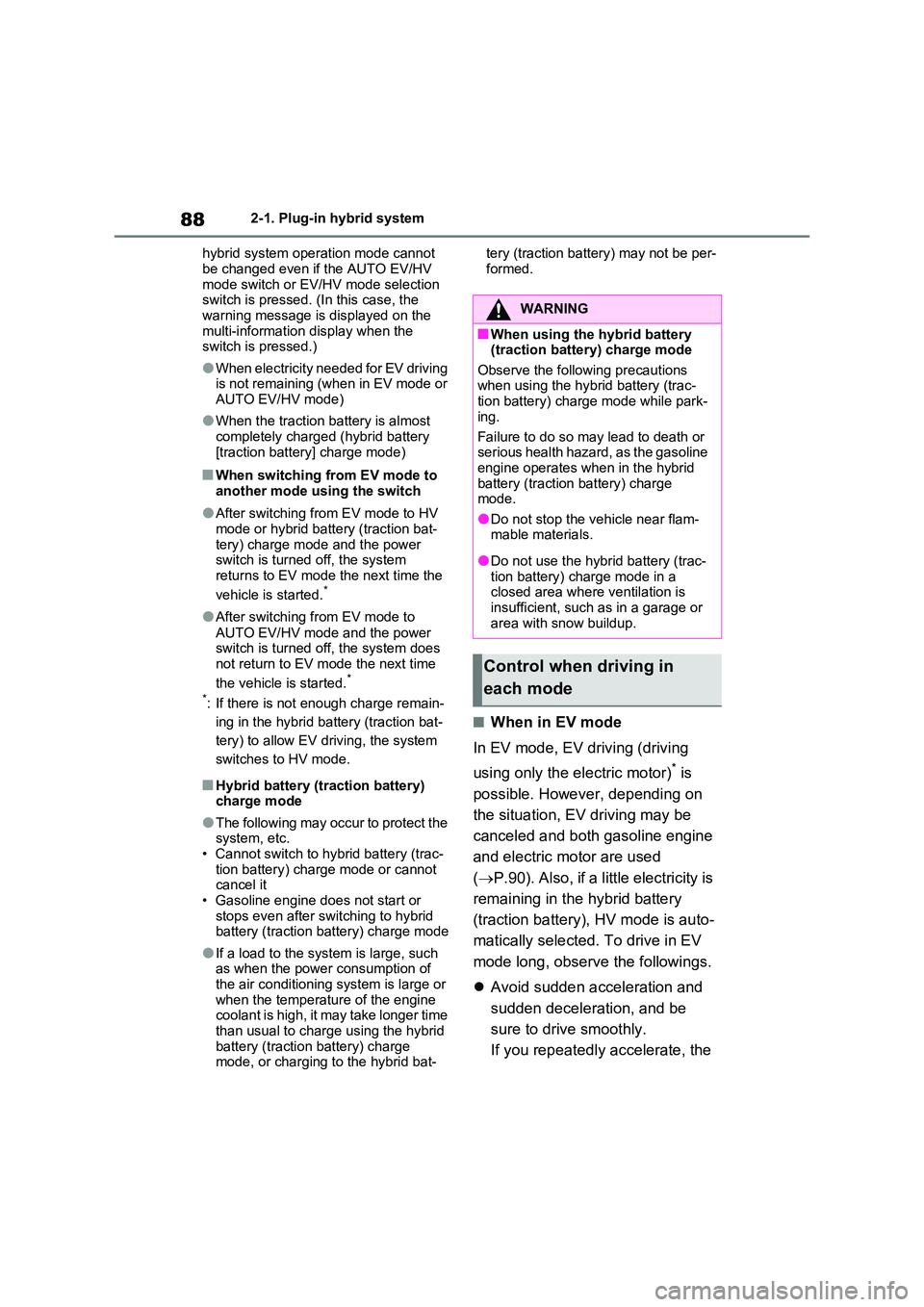
882-1. Plug-in hybrid system
hybrid system operation mode cannot
be changed even if the AUTO EV/HV mode switch or EV/HV mode selection switch is pressed. (In this case, the
warning message is displayed on the multi-information display when the switch is pressed.)
●When electricity needed for EV driving is not remaining (when in EV mode or
AUTO EV/HV mode)
●When the traction battery is almost
completely charged (hybrid battery [traction battery] charge mode)
■When switching from EV mode to another mode using the switch
●After switching from EV mode to HV
mode or hybrid battery (traction bat-
tery) charge mode and the power switch is turned off, the system returns to EV mode the next time the
vehicle is started.*
●After switching from EV mode to
AUTO EV/HV mode and the power switch is turned off, the system does
not return to EV mode the next time
the vehicle is started.*
*: If there is not enough charge remain-
ing in the hybrid battery (traction bat-
tery) to allow EV driving, the system
switches to HV mode.
■Hybrid battery (traction battery) charge mode
●The following may occur to protect the system, etc.
• Cannot switch to hybrid battery (trac- tion battery) charge mode or cannot cancel it
• Gasoline engine does not start or stops even after switching to hybrid battery (traction battery) charge mode
●If a load to the system is large, such as when the power consumption of
the air conditioning system is large or when the temperature of the engine coolant is high, it may take longer time
than usual to charge using the hybrid battery (traction battery) charge mode, or charging to the hybrid bat-
tery (traction battery) may not be per-
formed.
■When in EV mode
In EV mode, EV driving (driving
using only the electric motor)* is
possible. However, depending on
the situation, EV driving may be
canceled and both gasoline engine
and electric motor are used
( P.90). Also, if a little electricity is
remaining in the hybrid battery
(traction battery), HV mode is auto-
matically selected. To drive in EV
mode long, observe the followings.
Avoid sudden acceleration and
sudden deceleration, and be
sure to drive smoothly.
If you repeatedly accelerate, the
WARNING
■When using the hybrid battery (traction battery) charge mode
Observe the following precautions when using the hybrid battery (trac-tion battery) charge mode while park-
ing.
Failure to do so may lead to death or serious health hazard, as the gasoline
engine operates when in the hybrid battery (traction battery) charge mode.
●Do not stop the vehicle near flam-mable materials.
●Do not use the hybrid battery (trac-tion battery) charge mode in a closed area where ventilation is
insufficient, such as in a garage or area with snow buildup.
Control when driving in
each mode
Page 93 of 718
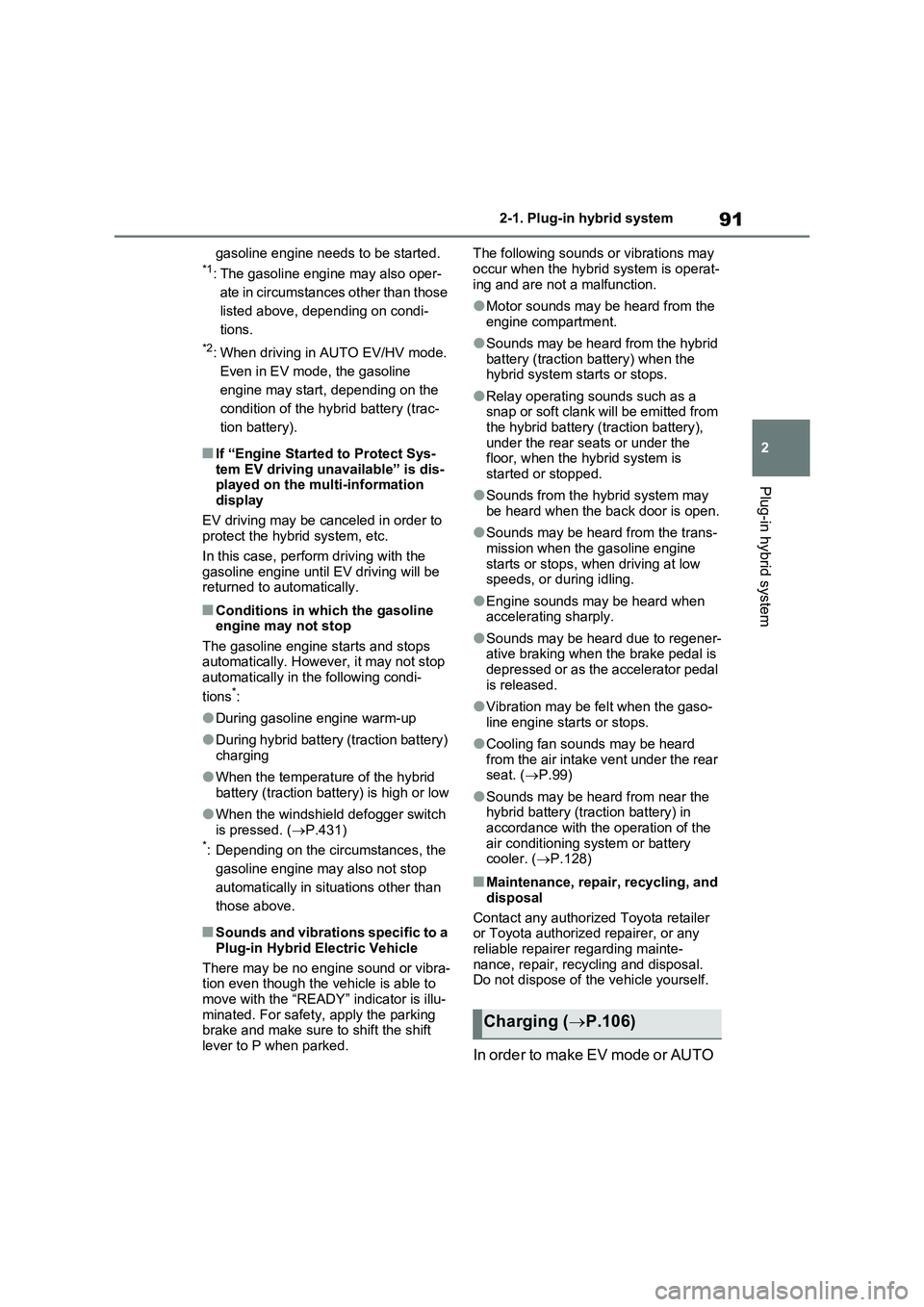
91
2 2-1. Plug-in hybrid system
Plug-in hybrid system
gasoline engine needs to be started.*1: The gasoline engine may also oper-
ate in circumstances other than those
listed above, depending on condi-
tions.
*2: When driving in AUTO EV/HV mode.
Even in EV mode, the gasoline
engine may start, depending on the
condition of the hybrid battery (trac-
tion battery).
■If “Engine Started to Protect Sys-
tem EV driving unavailable” is dis-
played on the multi-information
display
EV driving may be canceled in order to
protect the hybrid system, etc.
In this case, perform driving with the
gasoline engine until EV driving will be
returned to automatically.
■Conditions in which the gasoline
engine may not stop
The gasoline engine starts and stops
automatically. However, it may not stop
automatically in the following condi-
tions
*:
●During gasoline engine warm-up
●During hybrid battery (traction battery)
charging
●When the temperature of the hybrid
battery (traction battery) is high or low
●When the windshield defogger switch
is pressed. (P.431)
*: Depending on the circumstances, the
gasoline engine may also not stop
automatically in situations other than
those above.
■Sounds and vibrations specific to a
Plug-in Hybrid Electric Vehicle
There may be no engine sound or vibra-
tion even though the vehicle is able to
move with the “READY” indicator is illu-
minated. For safety, apply the parking
brake and make sure to shift the shift
lever to P when parked.The following sounds or vibrations may
occur when the hybrid system is operat-
ing and are not a malfunction.
●Motor sounds may be heard from the
engine compartment.
●Sounds may be heard from the hybrid
battery (traction battery) when the
hybrid system starts or stops.
●Relay operating sounds such as a
snap or soft clank will be emitted from
the hybrid battery (traction battery),
under the rear seats or under the
floor, when the hybrid system is
started or stopped.
●Sounds from the hybrid system may
be heard when the back door is open.
●Sounds may be heard from the trans-
mission when the gasoline engine
starts or stops, when driving at low
speeds, or during idling.
●Engine sounds may be heard when
accelerating sharply.
●Sounds may be heard due to regener-
ative braking when the brake pedal is
depressed or as the accelerator pedal
is released.
●Vibration may be felt when the gaso-
line engine starts or stops.
●Cooling fan sounds may be heard
from the air intake vent under the rear
seat. (P.99)
●Sounds may be heard from near the
hybrid battery (traction battery) in
accordance with the operation of the
air conditioning system or battery
cooler. (P.128)
■Maintenance, repair, recycling, and
disposal
Contact any authorized Toyota retailer
or Toyota authorized repairer, or any
reliable repairer regarding mainte-
nance, repair, recycling and disposal.
Do not dispose of the vehicle yourself.
In order to make EV mode or AUTO
Charging (P.106)
Page 98 of 718
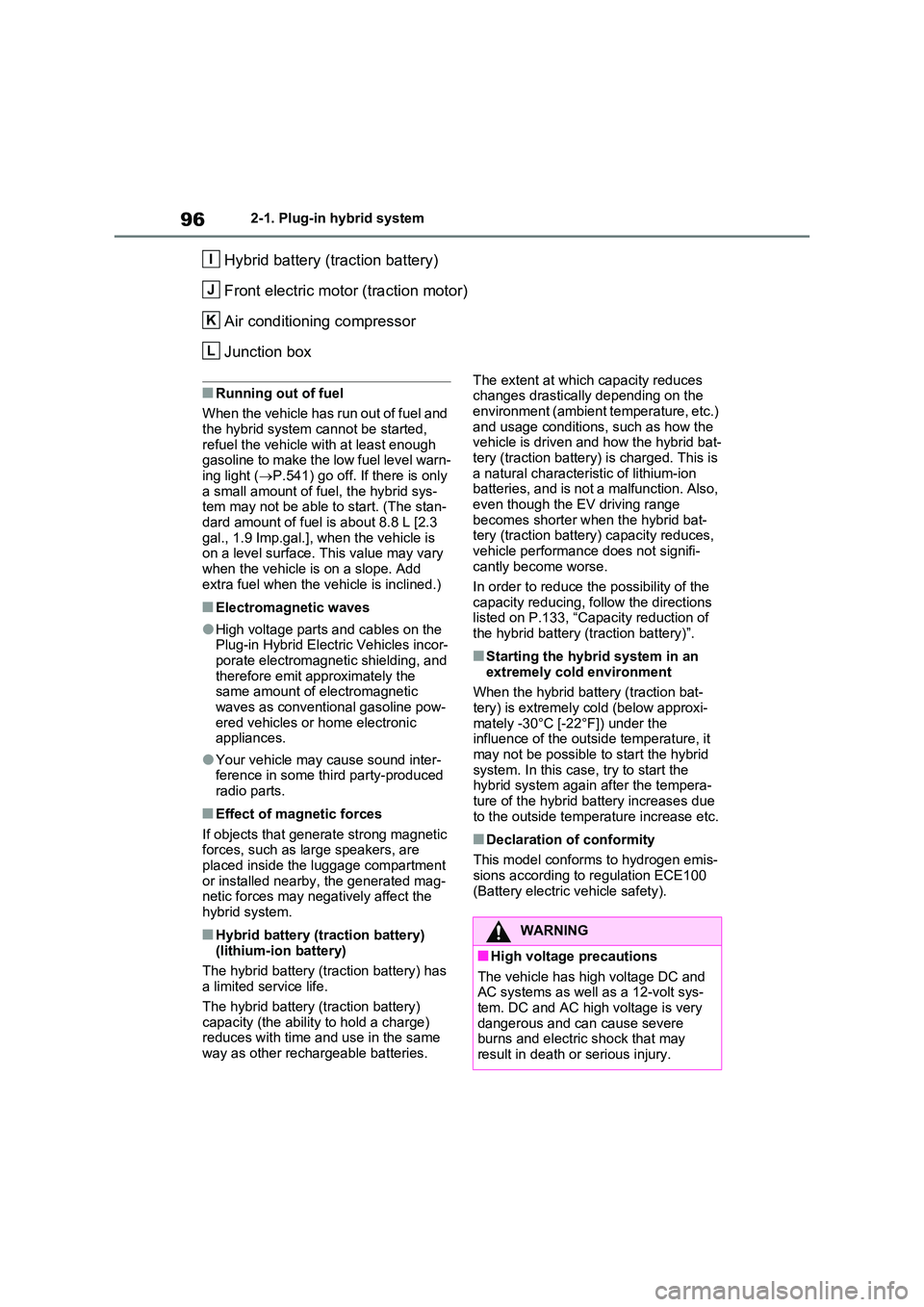
962-1. Plug-in hybrid system
Hybrid battery (traction battery)
Front electric motor (traction motor)
Air conditioning compressor
Junction box
■Running out of fuel
When the vehicle has run out of fuel and
the hybrid system cannot be started, refuel the vehicle with at least enough gasoline to make the low fuel level warn-
ing light ( P.541) go off. If there is only a small amount of fuel, the hybrid sys-tem may not be able to start. (The stan-
dard amount of fuel is about 8.8 L [2.3 gal., 1.9 Imp.gal.], when the vehicle is on a level surface. This value may vary
when the vehicle is on a slope. Add extra fuel when the vehicle is inclined.)
■Electromagnetic waves
●High voltage parts and cables on the Plug-in Hybrid Electric Vehicles incor-porate electromagnetic shielding, and
therefore emit approximately the same amount of electromagnetic waves as conventional gasoline pow-
ered vehicles or home electronic appliances.
●Your vehicle may cause sound inter-ference in some third party-produced radio parts.
■Effect of magnetic forces
If objects that generate strong magnetic forces, such as large speakers, are placed inside the luggage compartment
or installed nearby, the generated mag- netic forces may negatively affect the hybrid system.
■Hybrid battery (traction battery)
(lithium-ion battery)
The hybrid battery (traction battery) has a limited service life.
The hybrid battery (traction battery) capacity (the ability to hold a charge) reduces with time and use in the same
way as other rechargeable batteries.
The extent at which capacity reduces changes drastically depending on the
environment (ambient temperature, etc.) and usage conditions, such as how the vehicle is driven and how the hybrid bat-
tery (traction battery) is charged. This is a natural characteristic of lithium-ion batteries, and is not a malfunction. Also,
even though the EV driving range becomes shorter when the hybrid bat-tery (traction battery) capacity reduces,
vehicle performance does not signifi- cantly become worse.
In order to reduce the possibility of the
capacity reducing, follow the directions listed on P.133, “Capacity reduction of the hybrid battery (traction battery)”.
■Starting the hybrid system in an
extremely cold environment
When the hybrid battery (traction bat- tery) is extremely cold (below approxi-
mately -30°C [-22°F]) under the influence of the outside temperature, it may not be possible to start the hybrid
system. In this case, try to start the hybrid system again after the tempera-ture of the hybrid battery increases due
to the outside temperature increase etc.
■Declaration of conformity
This model conforms to hydrogen emis- sions according to regulation ECE100
(Battery electric vehicle safety).
I
J
K
L
WARNING
■High voltage precautions
The vehicle has high voltage DC and AC systems as well as a 12-volt sys-tem. DC and AC high voltage is very
dangerous and can cause severe burns and electric shock that may result in death or serious injury.
Page 102 of 718
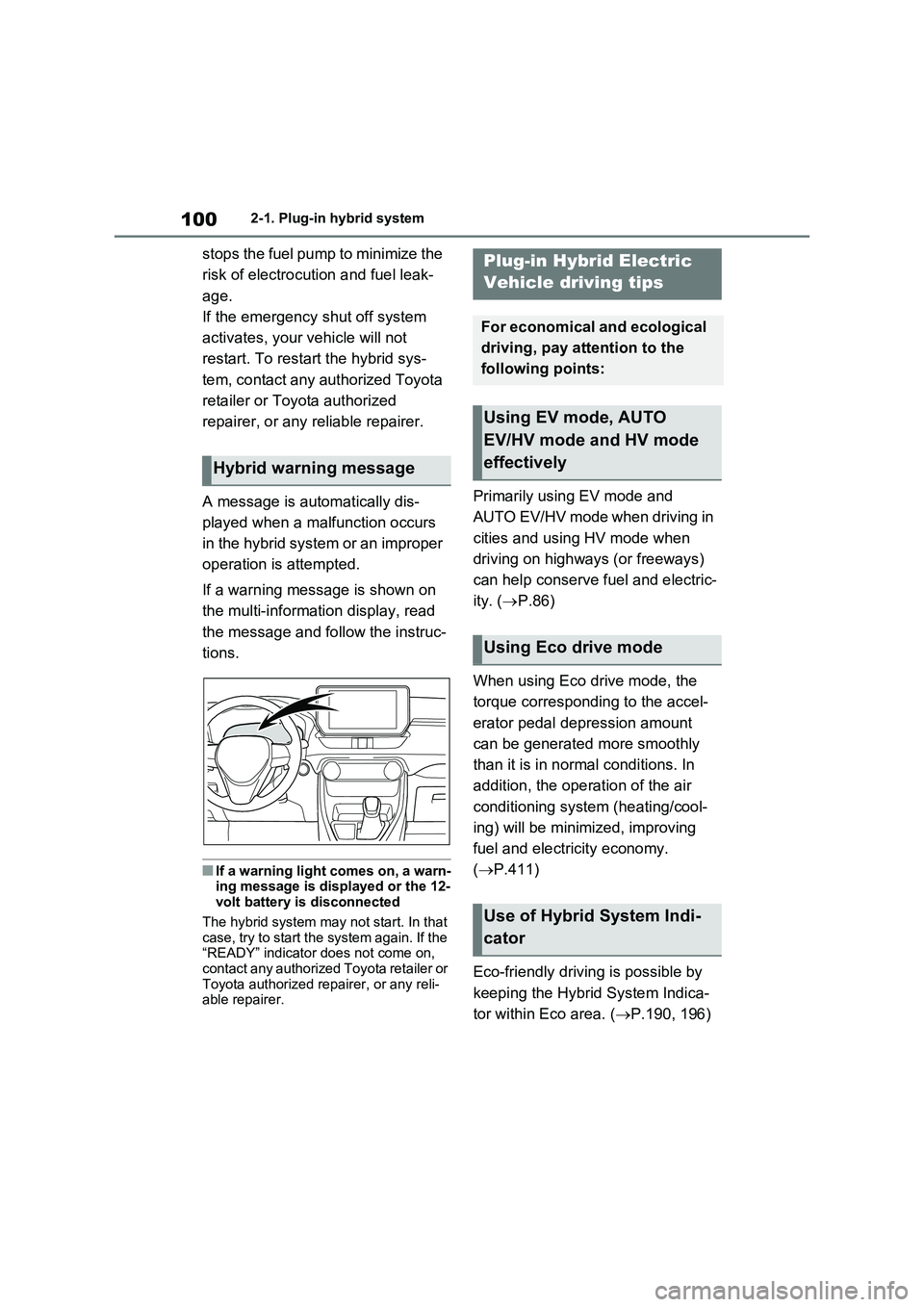
1002-1. Plug-in hybrid system
stops the fuel pump to minimize the
risk of electrocution and fuel leak-
age.
If the emergency shut off system
activates, your vehicle will not
restart. To restart the hybrid sys-
tem, contact any authorized Toyota
retailer or Toyota authorized
repairer, or any reliable repairer.
A message is automatically dis-
played when a malfunction occurs
in the hybrid system or an improper
operation is attempted.
If a warning message is shown on
the multi-information display, read
the message and follow the instruc-
tions.
■If a warning light comes on, a warn-
ing message is displayed or the 12-
volt battery is disconnected
The hybrid system may not start. In that
case, try to start the system again. If the
“READY” indicator does not come on,
contact any authorized Toyota retailer or
Toyota authorized repairer, or any reli-
able repairer.
Primarily using EV mode and
AUTO EV/HV mode when driving in
cities and using HV mode when
driving on highways (or freeways)
can help conserve fuel and electric-
ity. (P.86)
When using Eco drive mode, the
torque corresponding to the accel-
erator pedal depression amount
can be generated more smoothly
than it is in normal conditions. In
addition, the operation of the air
conditioning system (heating/cool-
ing) will be minimized, improving
fuel and electricity economy.
(P.411)
Eco-friendly driving is possible by
keeping the Hybrid System Indica-
tor within Eco area. (P.190, 196)
Hybrid warning message
Plug-in Hybrid Electric
Vehicle driving tips
For economical and ecological
driving, pay attention to the
following points:
Using EV mode, AUTO
EV/HV mode and HV mode
effectively
Using Eco drive mode
Use of Hybrid System Indi-
cator
Page 104 of 718
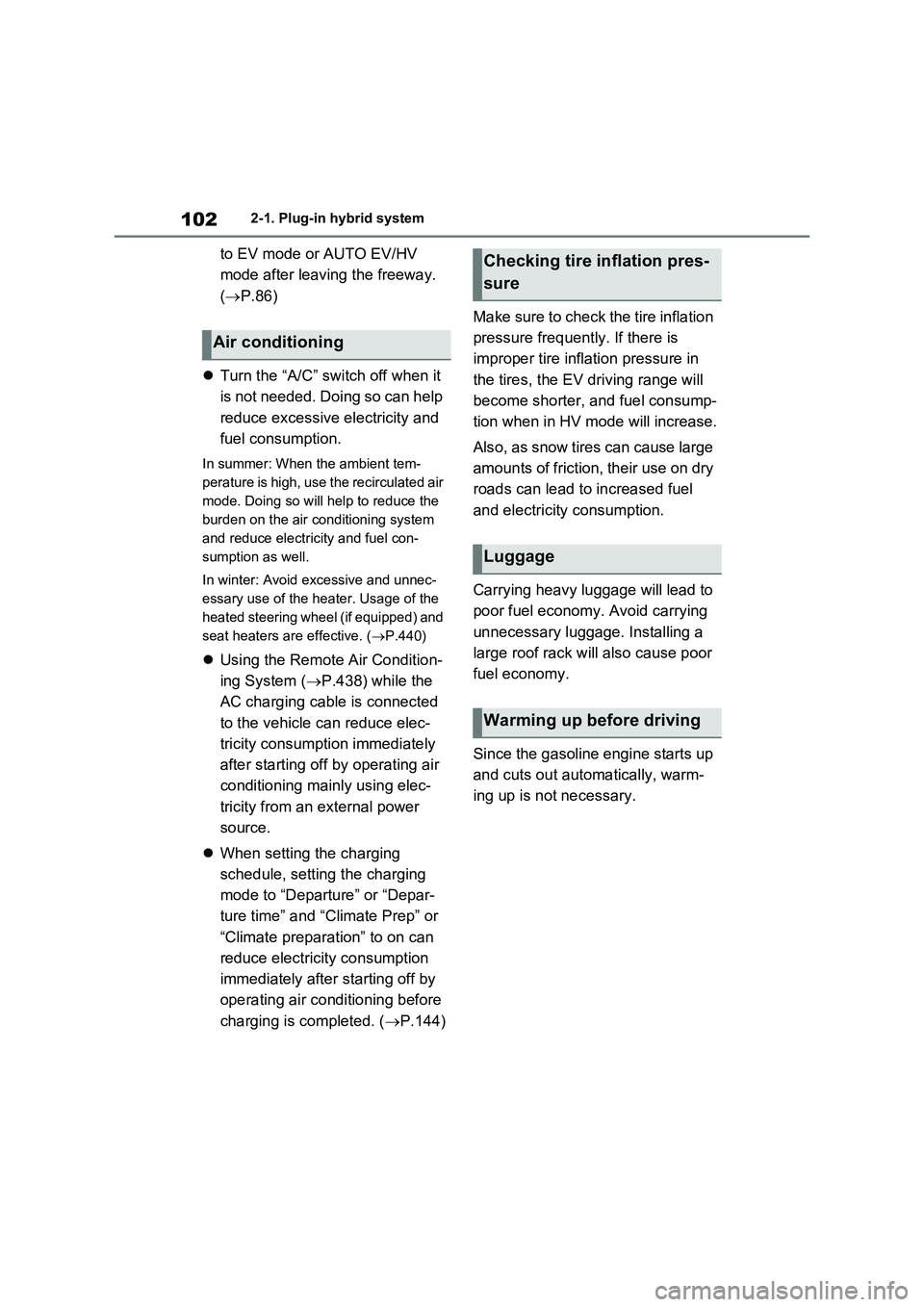
1022-1. Plug-in hybrid system
to EV mode or AUTO EV/HV
mode after leaving the freeway.
(P.86)
Turn the “A/C” switch off when it
is not needed. Doing so can help
reduce excessive electricity and
fuel consumption.
In summer: When the ambient tem-
perature is high, use the recirculated air
mode. Doing so will help to reduce the
burden on the air conditioning system
and reduce electricity and fuel con-
sumption as well.
In winter: Avoid excessive and unnec-
essary use of the heater. Usage of the
heated steering wheel (if equipped) and
seat heaters are effective. (P.440)
Using the Remote Air Condition-
ing System (P.438) while the
AC charging cable is connected
to the vehicle can reduce elec-
tricity consumption immediately
after starting off by operating air
conditioning mainly using elec-
tricity from an external power
source.
When setting the charging
schedule, setting the charging
mode to “Departure” or “Depar-
ture time” and “Climate Prep” or
“Climate preparation” to on can
reduce electricity consumption
immediately after starting off by
operating air conditioning before
charging is completed. (P.144)Make sure to check the tire inflation
pressure frequently. If there is
improper tire inflation pressure in
the tires, the EV driving range will
become shorter, and fuel consump-
tion when in HV mode will increase.
Also, as snow tires can cause large
amounts of friction, their use on dry
roads can lead to increased fuel
and electricity consumption.
Carrying heavy luggage will lead to
poor fuel economy. Avoid carrying
unnecessary luggage. Installing a
large roof rack will also cause poor
fuel economy.
Since the gasoline engine starts up
and cuts out automatically, warm-
ing up is not necessary.
Air conditioning
Checking tire inflation pres-
sure
Luggage
Warming up before driving
Page 105 of 718
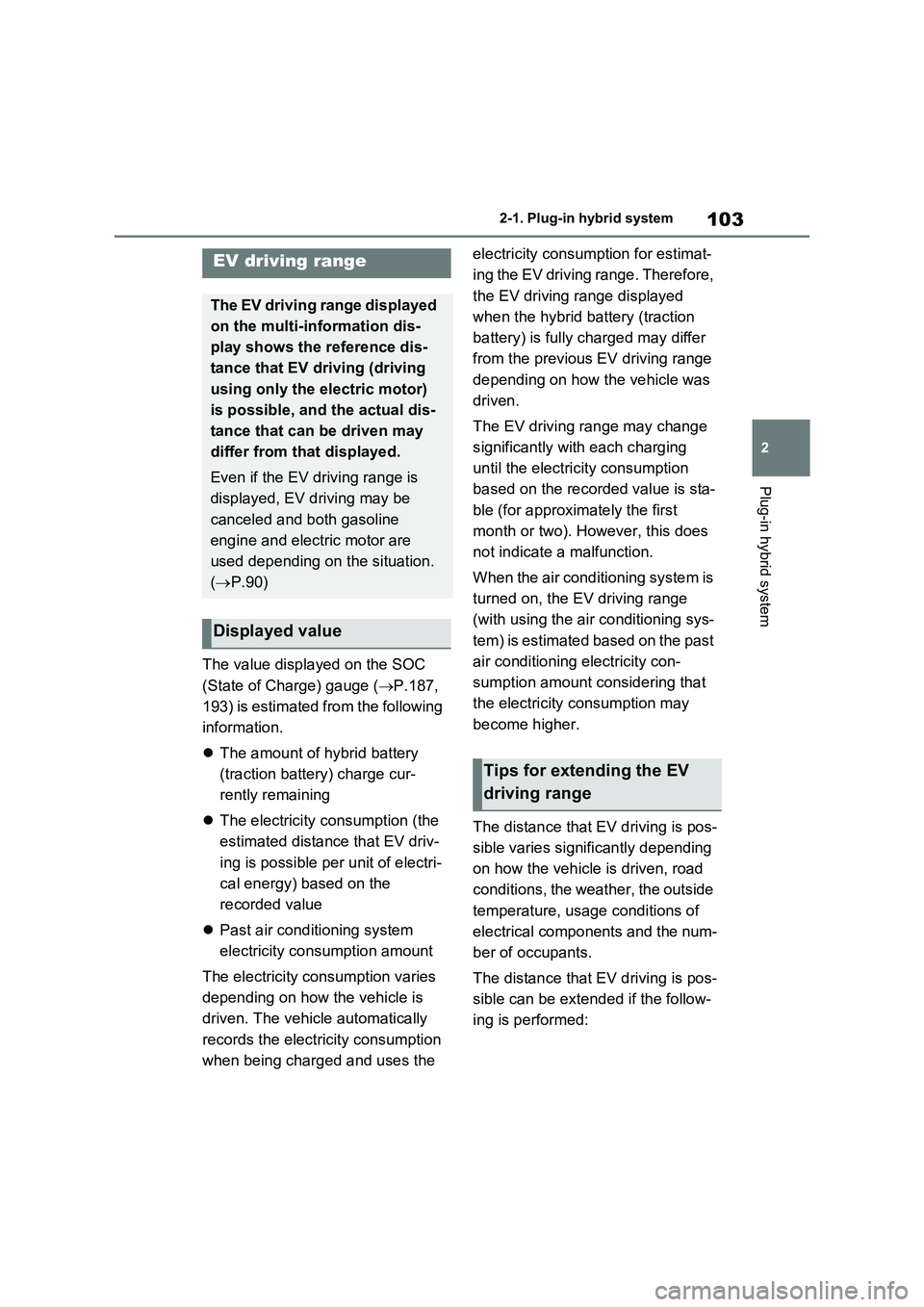
103
2 2-1. Plug-in hybrid system
Plug-in hybrid system
The value displayed on the SOC
(State of Charge) gauge (P.187,
193) is estimated from the following
information.
The amount of hybrid battery
(traction battery) charge cur-
rently remaining
The electricity consumption (the
estimated distance that EV driv-
ing is possible per unit of electri-
cal energy) based on the
recorded value
Past air conditioning system
electricity consumption amount
The electricity consumption varies
depending on how the vehicle is
driven. The vehicle automatically
records the electricity consumption
when being charged and uses the electricity consumption for estimat-
ing the EV driving range. Therefore,
the EV driving range displayed
when the hybrid battery (traction
battery) is fully charged may differ
from the previous EV driving range
depending on how the vehicle was
driven.
The EV driving range may change
significantly with each charging
until the electricity consumption
based on the recorded value is sta-
ble (for approximately the first
month or two). However, this does
not indicate a malfunction.
When the air conditioning system is
turned on, the EV driving range
(with using the air conditioning sys-
tem) is estimated based on the past
air conditioning electricity con-
sumption amount considering that
the electricity consumption may
become higher.
The distance that EV driving is pos-
sible varies significantly depending
on how the vehicle is driven, road
conditions, the weather, the outside
temperature, usage conditions of
electrical components and the num-
ber of occupants.
The distance that EV driving is pos-
sible can be extended if the follow-
ing is performed:
EV driving range
The EV driving range displayed
on the multi-information dis-
play shows the reference dis-
tance that EV driving (driving
using only the electric motor)
is possible, and the actual dis-
tance that can be driven may
differ from that displayed.
Even if the EV driving range is
displayed, EV driving may be
canceled and both gasoline
engine and electric motor are
used depending on the situation.
(P.90)
Displayed value
Tips for extending the EV
driving range